11-19-11
George Legrady’s Refraction:
Research in the Form of a Spectacle
By Diane Sippl
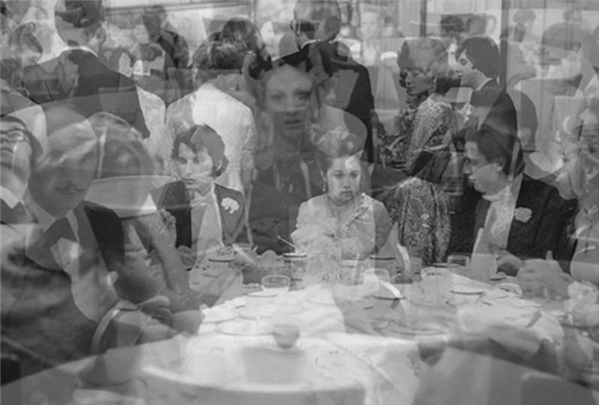
George Legrady, “At the Table,” 2011, Lenticular photographic print, 32 x 47 in.
Cinema, Truffaut said, is spectacle — Méliès — and research — Lumière…. If I analyze myself today, I see that I have always wanted, basically, to do research in the form of a spectacle.
Jean-Luc Godard, writer and director of cinema and video, Godard on Godard, 1972
For me mise-en-scène is not merely the gap between what we see and feel on the screen and what we can express in words, but is also the gap between the intention of the director and his effect upon the spectator.
Andrew Sarris, film critic, Film Comment, 1965
…even though I was familiar with the language and the customs, …my ‘Hungarian’ identity as I knew it had only a ghost-like resemblance to the culture which was in place. Time has gone by and I find myself displaced between three cultures, part of each but belonging to none.
George Legrady, multi-media artist, Parachute, 1998
We move in the world and by moving we discover and understand. The human being is a moving being — physically and spiritually — and not a stationary one. The moving image is thus a thinking image.
Fred Kelemen, cinematographer and filmmaker, Cinema Scope, 2011
Please pardon my opening with all these epigrams — there are so many ways to enter George Legrady’s current multi-media project, Refraction, at Edward Cella Art + Architecture in Los Angeles, that I can’t resist. Abigail Solomon-Godeau’s essay in the handsome and useful exhibition catalogue provides theoretical and historical context for a number of the works, and the catalogue itself shows the individual photographs used to create the larger compositions I will discuss. So I must claim at the outset that my forays into Legrady’s art stem from my individual interests in cinema and its relation to photography, especially in the context of very recent filmmaking in the world and my personal experience with cultures here and abroad. The mere fact that what follows is written in the first-person-singular voice must already say something remarkable about Legrady’s work — that it absolutely demands a subjective engagement and response. I usually write my commentaries using the rhetorical “we,” but with Refraction, I see no other way than to speak as “I” and presume that, among other voices, mine is relevant.
On the one hand, Legrady defines “refraction” quite simply — as light waves that change their direction and form when they enter a different medium. As he continues to comment on his oeuvre, he suggests that time, the means of expression, and spectatorship are also aspects of refraction: first, he reminds us that he shot the original photographs used in this exhibition nearly forty years ago, and now they are “found” images that have become source material for his recent artistic output; second, he points out that the digital medium has transformed the works through lenticular processing; and third, he explains that the viewing process itself is a kind of refraction because it relies upon the active participation of the viewer. In a public gallery talk with screenwriter/playwright Erin Cressida Wilson last week, Legrady suggested that Refraction gives rise to fundamental questions of the relation between narrative and cinema and the relation between text and performance.
In addressing these last two very broad fields of interest in the context of the art on exhibit — precisely the eight works of photography in the main gallery hall (because there are also three separate and related installations) — I would like to take up each of the three aspects of refraction Legrady has highlighted and consider them in relation to both cinema and performance, but by stressing elements of photography and cinema that are often overlooked, even if for reasons that can be very easily understood. In bold relief, my tenets can be summed up as follows: the fundamental filmic principle is not simply montage (an editing system of cutting and splicing, even digitally), nor is it primarily space (the relation of images within a given frame), nor is it fundamentally narrative (the consequential relation of events even if their sequence is “out of order”). These premises lead to a consideration of what photography has in common with cinema, and as Legrady presents it, with other arts as well.
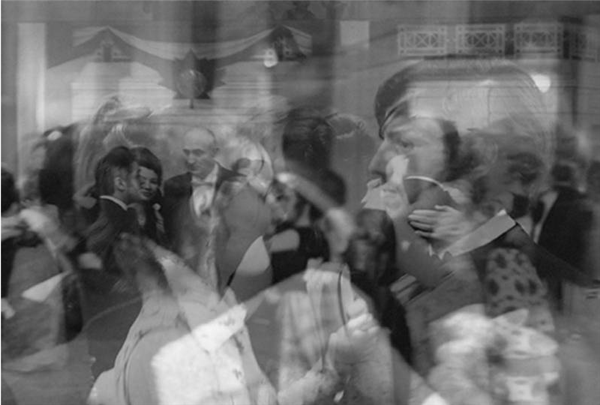
George Legrady, “Movement,” 2011, Lenticular photographic print, 32 x 47 in.
Tableaux Vivants
“My family had emigrated from Hungary to Canada,” Legrady tells us, “and when I returned home to Montreal from a trip to India in 1972, I photographed the annual Hungarian Ball. I was looking at two groups, the guests and the staff, the infrastructure.” Reviewing his work, he relates, “These images, once found accidentally, impressed me because they looked staged. Yet no one really noticed me shooting.”
Significantly, Legrady shot the photographs (at least those he uses in this work) in black and white film using ambient light that is often visible in chandeliers, lamps and candles but is also reflected and refracted in mirrors, numerous window panes, and endless bottles, pitchers, and glasses, even shiny countertops, altogether giving the illusion of high-key lighting from the classical era of cinema portraying “the good life.” In the enclosed setting, a ball/banquet room, densely saturated with people and tables, dinnerware, food, drink, and décor, we could be in the worlds of Phillip Barry, Noel Coward, and Ernst Lubitsch at once. Legrady’s camera here almost always uses deep focus and almost never finds a shadow. Generally he uses a wide angle at eye level, even with particular figures in the foreground.
Already among these separate shots, many resembling still publicity photographs from “the movies,” he captures the lines and shapes that bring dynamic movement and tension to the frame (Eisenstein, always the graphic artist before, during, and after his filmmaking, was a master of this), often catching a circulation of looks (and expressive “disconnects”) that suggest stories foretold, distorted as they will be in their recollection and repetition later. An individual photograph offers its own semantics of desire, flirtation, observation, rivalry, reservation, distraction. Gowns and coiffures, tuxedos and ties, suggest back-stories that resurrect Anna Karenina and Count Vronsky even if only on celluloid on Russian screens of the (19)70s — in large part, the selection and configuration of images is timeless and universal within a particular social class and its attendant service workers.
“Recently out of the 121 photographs I shot, I selected 24 for the computer processing of 8 compositions, using 3 different photographs in each of the 8 panels,” Legrady continues. “Lenticular processing is about layers. I’ve arranged the three layers in each work so that the transitional event is in the middle, and I accentuate the overlap, the blur. From six to eight feet away, the image becomes quite clear, but closer up, it’s a blur.”
As formed by the superimposition of lenticular screens (a technique used in popular culture as early as the 1940s), the eight composite images, all 32 inches high and 47 inches wide (an aspect ratio comparable to the “Academy ratio” of 1.37:1 used in classical cinema up to the early 1950s) provide a playful platform for reception today through the combined use of media that feel either anachronistic or charmingly antiquated depending on the viewer’s frame of reference and taste. And because by design, they literally “move the body” to be seen — each individual spectator’s body — the viewing experience can almost become as subjective as that of entering a hall of mirrors. Metaphorically speaking, Legrady gives us the “cut shards” of life (the images he has witnessed and materialized in the frames before us) and we turn our own kaleidoscopes, cranking our own compositions as our legs do the walking. With the oscillating images before us, we create our own dreamscapes to the extent that we do in any cinematic experience. In a sense our subjectivities (in large part, socially, historically, and psychologically determined) animate his images as he animates our bodies; together we create a new kind of “motion picture.”
Is he releasing the power of interpretation, the responsibility of making meaning, to us? After decades of modernist and postmodernist theory that advanced in tandem with the evolution of the cinema, we know that it was always there. So why take up this enterprise today? Is it an act of identity, a fight against cultural amnesia, a retrieval of personal memory, a matter of nostalgia? (Theory practitioners from Alain Resnais to Chris Marker to Roland Barthes have all placed value in such sustained enactments of individual and shared history). Legrady knew the people at the ball in varying degrees through the Hungarian community.
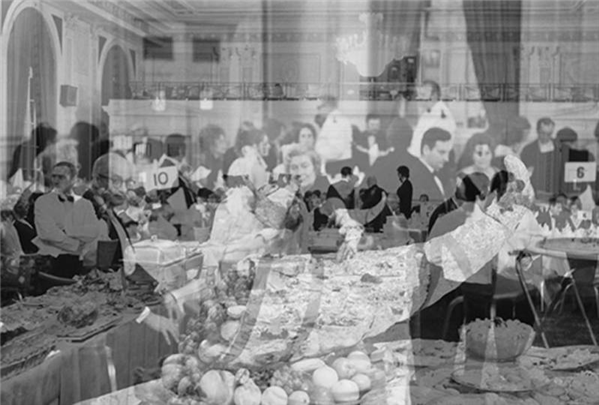
George Legrady, “Cornucopia,” 2011, Lenticular photographic print, 32 x 47 in.
The Big Thaw: Subversive Animation
In a 1953 essay, “The Virtues and Limitations of Montage,” film critic and theorist André Bazin challenged the montage theories of Eisenstein and German Expressionism by noting that from the beginning it was cinema’s possibility to capture existing reality, rather than its power to create new images, that was its most radical potential. Refusing to reduce the cinematic principle to the juxtaposition of discrete images (a spatial arrangement of contiguity that produces a sense of continuity in “associative editing”), Bazin stressed that cinema derived from photography and the camera’s capacity for automatism, for producing an accurate representation of the world “by accident.” Not only that, the camera endowed everyday objects, figures, and faces with a captivating luminosity, as evidenced by Lumière’s simple “documents” of life. The experience for the spectator of a particular expression or play of light was spontaneous, intermittent, and singular, but all the more acutely felt as a direct relation with the “real.” In fact this photogénie, present but somehow indescribable, invited lyrical contemplation that often seemed hampered by an imposed narrative.
Both the Impressionists and the Surrealists marveled this unique property of photography and filmmaking alike; whether it was in the hands of gifted and experienced artists or lay practitioners, the revelatory power of the camera was astonishing, even if the effect in its pure state seemed irreducible to words. Of course Bazin went on to champion the carefully calibrated use of this potential by Renoir, De Sica, Murnau, and Flaherty as they allowed what the camera found on location to emerge in its own element, and by Wyler and Welles, who accentuated the medium’s potential by favoring the use of long takes and deep-focus camera work that invited extended and expanded engagement on the part of the spectator.
Proclaiming his “resistance to the cinema,” Roland Barthes argued in his 1970 essay, “The Third Meaning,” that in response to the movies’ onslaught of images serving only to underscore a narrative, he felt the need to stop the film. Pulling out individual frames from Eisenstein’s films to break the effect of their editing, he was able to simulate the experience of traveling in a foreign land without its language. Why do this? The attempt was to reproduce the habit of moving, as André Breton did, from one cinema hall to another without knowing what would be screening or when, just “dropping in” for a time to look at the screen and leaving as soon as the meaning became too clear. A surrealist’s mode of film reception (or should we say, “participation”?) so as to encounter images outside of any plot drew his eye to details whose meaning could be traced neither to information nor to symbolism. For Barthes, these superfluous details, “signifiers without signifieds,” were the essence of the photographic image. Their obtuseness, wrote Barthes, “indifferent to the story… outplays meaning — subverts not the content but the whole practice of meaning.”
In Barthes’ classic theoretical tract, it is only at the level of the third meaning that the “filmic” finally emerges, that which cannot be described, “the representation which cannot be represented.” For Barthes, the filmic (whether photographic or cinematic) begins precisely where language and meta-language end. And this end is, in turn, exactly where questions, learning, can begin. The fetishizing, or over-valuing, of seemingly insignificant details that are nonetheless photogenic for the spectator becomes a research strategy that opens new doors, new approaches to a problem, as Barthes demonstrates through two films, Hitchcock’s Rear Window and Antonioni’s Blow-Up. Is such a practice relevant to today’s electronic age, and if so, what would it look like, and how would it work? Might it draw from the interplay of photography, cinema, and the computer as they compel the activity of the spectator?
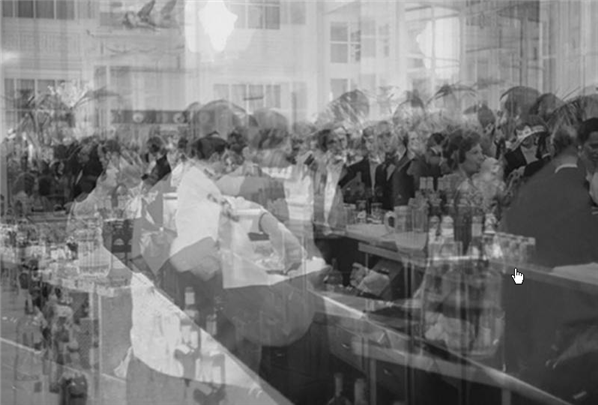
George Legrady, “At the Bar,” 2011, Lenticular photographic print, 32 x 47 in.
Through the Viewfinder: A Clock with No Hands
The fundamental cinematic concept of Legrady’s “refractions” positions me as a motion picture camera performing an ongoing dance, itself a celebration of cinematic movement. Granted, in structuring and labeling the eight large photographic compositions on the gallery wall, Legrady has given me what amounts to his own overall “montage” of these eight “extended plan-sequence takes”; he has already “cut” the 24 frames of images that comprise his single “film,” Refraction, divided them among eight “sequences” (each with its own verbal title), and organized the three frames of each sequence with his own syntax. But he has left that syntax open just enough for me to enter the filmmaking process when I try out the angle, distance, and duration for each of my newly composed “shots” as I move the position of my own body before each artwork. These shots are neither focused with the precision of his photography nor are they materialized as his are; they are as ephemeral as a “dissolve” in a film but nonetheless they make an impression. And I call it an “impression” and not an “event” because the dissolve is working very differently here from the way in which it signals an ellipsis in conventional narrative cinema, economically condensing time before the next significant event. Here the elision is not one of time but of language. My newly created time follows my subjective pace — and space — of recollection, forecast, and presence, of history, memory, and reverie.
My constantly roving camera eye leads my curiosity as I test the static images for readability in my movement. Not only has the lenticular processing of the images animated me, but I find myself animating a series of tableaux vivants, freeing their frozen motion as I “pull focus” or zoom in or out by stepping forward or backward. As I do this, the black-and-white photography allows for both more clarity and more subtlety in the multiple superimpositions of the images than color film would permit. While Vlado Škafar’s recent Slovenian film, Dad relies entirely upon the fading in and fading out of color images, the dissolve is generally between two images (father and/or son) and no more. The dissolves I make of Legrady’s shots are far more complex; not only are there three layers of frames in front of me, but repetitions of objects and the human figure abound within each frame/layer, so then my movement either implodes the frame with new resonance, readable or not for any precise meaning, but nonetheless imparting a sensation, or expands the frame, lending the illusion of another space entirely, perhaps one outside in a courtyard or plaza on a busy city street, as in Legrady's “At the Bar.”
The continuously-changing image before me not only generates mystery in its effect, but because the space between the images has been demarcated by the medium of lenticular processing — that is, it has been authorized for my participation — yet offers me no particular resolution, in fact little chance of any resolution, my experience is a destabilizing one. Generally in cinema, the reverse moving shot provides more information for the spectator, and Legrady’s photographs become cinematic in this way: as I step back a few paces, their images become clearer, as does their relation to the whole frame and overall “film.”
When I control the tempo of my gaze, slow it down, not only do I feel Refraction’s lyrical potential in my movement — that is, the aspect of tending or pending or moving toward a connection among its images, even in their suspension — but I also notice the shot-within-a-shot style that appears in my oblique perspectives or changes of focus. For example, no less than ten hands in “Movement” generate strange new embraces. My “parallel tracking shots,” in either one direction or the other, right or left, transform the composition of images. As they are changing, my perception/reception is changing as well. Meanwhile, it is a very kinetic, physical performance on my part, varying from rough to fluid with my movements.
Because Legrady’s “cuts” are the three separate frames he chooses to superimpose, the time he allows me to create is layered, not linear. The syntax is poetic in its density and resonance within and among frames and also choreographic as I animate it, because not only is there tension within the mise-en-scène of each photographed frame, but there is also the tension between my slow reception and a dynamic scene. At this stage we are talking about another kind of time entirely: cinema is not fundamentally dependent on literature or narrative; as a visual art, it has much more to do with music — its tempo and meter, repetition and rhythm, tone and harmony.
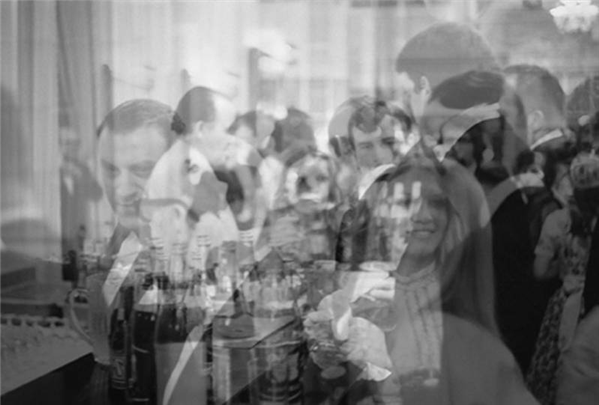
George Legrady, “Magnetic,” 2011, Lenticular photographic print, 32 x 47 in.
A Conversation without Words
Finally, what would so many words here (the “research”) be worth without indulging in the art (the “spectacle”)? Hence, a few particulars, test cases in the rush of grand ideas…
Loves of a Blonde
One of the simplest and clearest examples of Legrady’s invitation to the dissolve, a soft transition in space, time, and situation reminiscent of earlier days of cinema, is available in his composition, “Magnetic.” I see three blondes in these frames, and they are as reminiscent of Hana Brejchová in Milos Forman’s 1965 Czech film (who “looks like a guitar,” her lover tells her, “but one painted by Picasso”) as they are of John Berger’s 1972 art history treatise and BBC television series, Ways of Seeing. “Men look; women appear,” Berger told us — at least that was the hidden ideology he saw in much of Western art history. But as I do my lateral tracking here, the blonde in the foreground with her back to me, with only her long golden tresses on display, disappears, and the blonde in the center of the frame, passively listening as all good “blondes” do, upstages her. And as I zoom in on this second blonde at the bottom of the frame, it is she who comes alive and carries the expression. The dissolve yields a triple exposure of men — bringing the superimposition of two men, “tall, dark and handsome” but faceless along with a third one, who has now turned forward to follow the blonde in close-up. She has motivated his movement and his new action in the frame (in feminist history of Hollywood, a sign of power for women on the screen), and she remains a double image. Like Andula in Foreman’s film, she does a lot more than “appear.” The refraction here is time, not only the moments of this woman’s movement, but the years in the mirror of my own historical movement, from Berger’s art discourse four decades ago to my own knowledge of world cinema today.
The Window View to a Machine
“At the Bar” is a (literally) wonderful example of implosion and expansion of the frame, of Freud’s unconscious condensation and displacement, all at once. In my movement through the three shots of the sequence, I transform the barman in the foreground, pouring a drink for one person, into an automaton serving an exponential number of guests. The frame bubbles over, spilling into a “city” street of shops or flats with windows peering down upon an orgy of drink in an outdoor piazza. The interior ferns loom as exterior palms. The mise-en-scène becomes exotic and impossibly robotic as three barmen are superimposed in motion, as if taking flight — wryly rhymed with the double image of stuffed birds that, once a peculiar décor inside, perched in the niche of the woodwork, dead as a doornail, now look like “birds on a wire” in the open air of the accelerated shot-sequence.
Land of Plenty
“Cornucopia” affords a delightful tension as the frames merge — I could even call it an emblem of all-out class warfare. A ridiculous horn (of paper maché or plywood) overflows with bounty onto the table as a centerpiece in each of the three frames, each time a different size amidst real people serving and consuming the real food. The juxtaposition between caterers and consumers is available in each frame, but we might more aptly label the separate frames as “product” (the long buffet of food), producers (the chefs or caterers in the foreground) and “production” (those who own the means, seated at their round tables in the background). As I move ever-so-selectively among the possible angles for juxtapositions, I locate an uncanny superimposition: suddenly the tall-hatted chefs whose hands were merely hanging at their sides in repose have “clasped” the full girth of the cornucopia, unwittingly as if it goes without saying. But wouldn’t you know? There is yet another arm stretched out upon this horn of plenty. The woman in the black dress, seated in the center of the frame at table 10, has caught them in the act, and as if directly addressing the camera (me!), begs the question, “Just what do you think you’re doing?” Hungary: an age-old fight between the “haves” and the “have-nots” — we see it again in the next sequence.
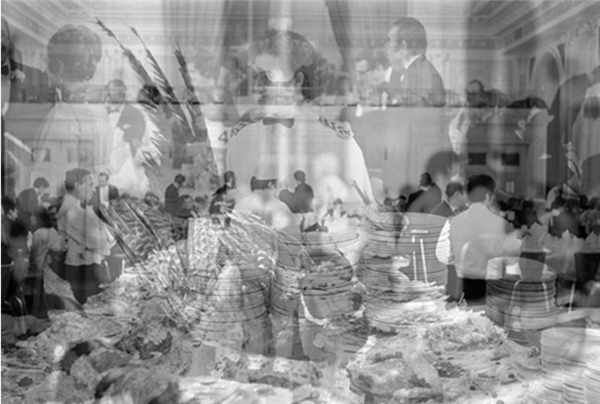
George Legrady, “Display,” 2011, Lenticular photographic print, 32 x 47 in.
In the Hall of Mirrors
Maybe “Display” is my favorite, if only because of the title and its ironic, open play on the word but also its Godardian play on the number as text. The figure “4” is a great example of accidental meaning: the stuffed birds (there are, amazingly, “4” of them, if we count the grand feathered pheasant on the doily, center-stage, and his diminutive counterpart slightly to the rear-right who looks like he’s roosting on a stack of dinner plates, along with the two edible stuffed birds, to the right and left of our fine, feathered friend) are certainly the text. But so, too, must be the pyramid-shaped feast centered within the frame with conspicuous symmetry and its white-hatted caterer (with his back to me) positioned in the middle of it all. Hardly subtext, though, is the handsome, hatless attendant standing center-frame behind the stacks of plates in all his regalia, who in the superimposition of the three shots looks like he’s the crowning prince upon the entire tower of abundance in the interior, shot-within-a-shot with its proscenium framing by the side walls and draped window behind him. Posed as such, he is the delicacy, the object of consumption, the object d’art, but he is juxtaposed with the stuffed bird Audubon-style (a hunted, killed object of taxidermy brought to life again by water color).
And in quarter-profile, what is he thinking? His thoughts, which I cannot know, refract my thoughts as I sashay before him, fetishizing him along with the birds as fragments of personal memory, film history, and recent experience all at once. He takes me to Hungary, 1983, to the exclusive dining room of Mafilm Studios, where for the first time (though I had cooked it myself for others at home) I was served by someone else my then favorite entrée: Chicken Kiev, this one in all its glory, with its white lacerated paper crown placed on its tiny bone once the breast was stuffed with herbs and fried. Authentically prepared, it spurts butter like a geyser when you pierce it with your fork for the first bite. Mine did — all over the damask tablecloth, Herend porcelain, Ajka stemware, and silver cutlery of the posh Budapest enclave of “royalty” so to speak — the Hungarian film studio. How would I have guessed, when I left the cinema classes I was teaching at UCLA and packed up to do research on Hungary’s auteur filmmakers — Miklós Jancsó and Márta Mészáros, Pál Gábor and Péter Gothár, Judit Elek and Judit Ember of Béla Balázs Studios, and numerous others, some whose films, I came to be told, put out “shop-window” socialism for the West — that I would live better in the “East” than at home? A month there never proved otherwise. Nor did it two years later when I returned. I was the bumpkin; they were the lords and ladies.
There was one among them I missed and only discovered later in Locarno. He was as modest as his films would be extravagant — not in terms of display, but quite the opposite, in terms of internal worth, the capacity of a work of art to transport me to another place, inside another world. That world was the “empty” villages outside the cities on the vast plains of Hungary (that I had crossed alone by car) where peasants eked out a dire, day-to-day subsistence that he captured in humble, trance-like, black-and-white epics that took half a day or more to watch. Sátántangó was the first for me, and now recently, The Turin Horse. I am speaking of Béla Tarr, and while I’m at it, also his long-time director of photography, Fred Kelemen, who many times came to mind as I first viewed Legrady’s Refraction — Kelemen with his moving, roving, tracking and fluidly zooming camera on the iconic horse of Hungarian myth and history. He and Tarr have taught me, once again, as has Tarkovsky, that cinema is “sculpting in time.” With no plots, no stories, and austerity in the immensity of their apocalyptic visions, they make me an active player in their rituals of everyday life.
In Refraction, George Legrady awakens viewers to their active roles in making the cinema or photography they experience. The dissolve and the shot-within-a-shot “move” the spectator; furthermore, they warrant experiments with new ways of making, viewing, and responding to images. Such experiments might, in turn, foster new kinds of critiques of the ways we produce and circulate information. I have discovered in Refraction, once again, that my performance as a spectator can lead me to an impromptu, flickering, and fleeting processing of images, one without resolution and one that is mine alone. While Manoel de Oliveira has recently shown me in The Strange Case of Angélica that the spectre can be resurrected from a photograph, Refraction offers me something else. Cinema might be “shadows dancing in the light,” but Refraction is “spectators dancing in the dark” — to the strange music of mirrors in a time of dreams.
George Legrady: Refraction
Edward Cella Art + Architecture 6018 Wilshire Blvd., Los Angeles, CA 90036 www.edwardcella.com Tel. 323-525-0053
November 5 to December 31, 2011